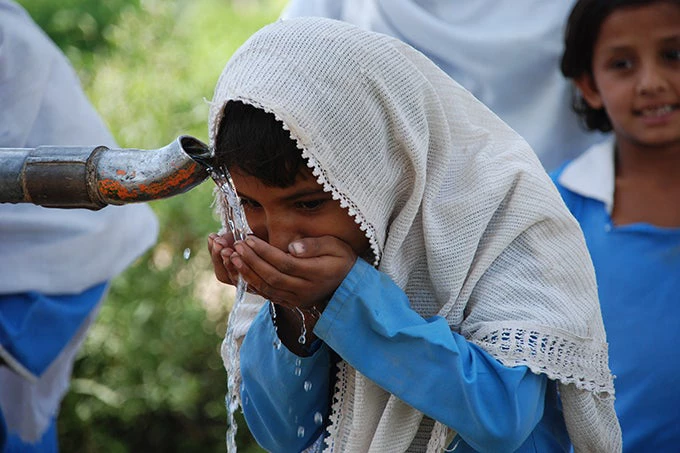
Environmental degradation is not only threatening environmental sustainability, but also Pakistan’s ability to tackle poverty, as well as its ability to generate a substantial share of its growth and employment.
Similarly, while Pakistan needs to think for the long term with regard to environmental sustainability, many of the actions it could take to control and reverse environmental degradation and adapt to climate change would have immediate benefits and be particularly helpful to the poorest, who are most vulnerable.
Last year, the federal government launched the Clean Green Pakistan Program.
This is a first excellent step.
Why? Because it is a people’s movement and everyone’s responsibility and focuses on behavioral change to create demand for better environmental services .
With this measure, the government is making urban communities, including school children, more aware of the value of natural resources in urban settings and importance of protecting them.
Harnessing the power of public pressure by access to environmental data is a key measure to be achieved through:
- disclosure of pollution data to engage citizens and encourage preventive actions;
- effectively engaging with local communities and relevant stakeholders in the city development planning processes; and
- education and raising awareness to empower citizens.
Pakistan can strengthen its environmental protection departments’ capacity to disclose environment information and engage citizens in environmental management through awareness campaigns on pollution and green development, as part of the Clean Green Pakistan initiative.
Education on environment and its function in an urban setting is critical for effective citizen engagement.
However, in the context of growing urbanization, and to achieve healthy cities and productive citizens, Pakistan could focus on the following choices.
Environmental Protection Agencies’ (EPA) and local governments’ environmental monitoring capacity can be improved in a coordinated manner among the provinces and the federal government. 
Most of the data about high pollution levels in Pakistan come from global datasets and monitoring is currently weak and lacks granularity.
A key mandate of EPAs is environmental monitoring.
The first step is to understand current pollution levels and sources by rebuilding the monitoring network, not only with equipment but also its protocols ; analytical capacity; and technical, institutional, and financial sustainability.
To plan an effective pollution reduction action plan, the authorities need to better understand the current pollution levels, concentration, trends, and sources .
Addressing pollution cannot be done without these basic monitoring features.
Pakistan has an opportunity to enhance the devolution with environmental decentralization, distinguishing between and revising federal, provincial, and local roles and responsibilities, which policy actions need to be taken by whom and how to coordinate it all, given boundary and efficiency issues.
This could start by focusing on the institutions with a core environmental mandate such as the provincial EPAs.

These entities have pressing needs of reforms in areas such as:
- estructuring and capacity building, including air and water quality management planning with appropriate labs and models, along with protocols and technical/financial capacity;
- regulatory reform; and
- information disclosure and citizen engagement.
- promote green financing, mainstreaming green investments in the public sector; and
- support the adoption of resource-efficient and clean production measures in polluting sectors.
The environment is everyone’s business and so the coordination mechanism among institutions needs to be effective and well-articulated.
Air and water pollution are the result of multiple interventions and causes.
The role of federal or provincial EPAs that were originally designed was to focus mainly on large point sources, but that is not enough.
Air quality, for example, is not only about regulating industry, energy, and vehicles.
It is also about investment in public transport, street and construction dust control (managed by local governments), waste management (by local governments), and fuels/stoves used by households and small establishments, as well as agricultural emissions.
Even with provincial EPAs strengthened, Pakistan is yet to develop the institutional coordination arrangements to manage the environmental challenges such as air or water quality at the airshed and watershed levels and should do so.
Incentivizing greener investments. When identifying growth opportunities for Pakistan, the poor state of environment and the looming climate change can also be turned into an opportunity for growth too .
The country needs massive and increased investments for growth and hence ‘greening’ investments are critical.
The only way to reconcile investments with sustainability and avoid excessive social and health costs is to make them ‘greener’ from the beginning .
For this, stronger regulation, enforcement, and EPAs are necessary, but these alone are not enough (and growth may even be stalled if these are not combined with other approaches).
Regulatory approaches must be complemented by incentives, economic tools, fiscal policies, and financing.
Pakistan needs a tax reform for higher investment, which represents an opportunity to design a greener tax regime that includes, for example, pro-growth, pro-poor environmental and carbon taxes, and the elimination of environment damaging subsidies (removal of subsidies for fuels consumed by motor vehicles and industries).
It also needs to have a better financing regime for industries and small and medium enterprises.
This is an opportunity to develop green financing that makes access easier for environmentally responsible enterprises and activities.
This article was originally published on March 25, 2019 in Dawn newspaper.

Join the Conversation